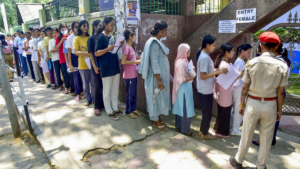Dear Aspirants,
Reasoning Ability is an onerous section. With the increasing complexity of questions, it becomes hard for one to give it the cold shoulder. The only way to make the grade in this particular section in the forthcoming banking exams is to practice continuously with all your heart and soul. And, to let you practice with the best of the latest pattern questions, here is the Adda247 Reasoning Quiz based on the exact same pattern of questions that are being asked in the exams.
Directions (1-5): Study the following information carefully and answer the questions.
Seven friends Manjil, Mayank, Anubhav, Bansi, Sajal, Monti and Lokesh attend different language classes, namely French, English, Spanish, Sanskrit, Chinese, German and Japanese, but not necessarily in the same order, from Monday to Sunday.
Manjil attends a class on Friday. Sajal is not learning Japanese. Only two persons attend classes between Manjil and the one who is learning Sanskrit. Monti attends a class immediately before Bansi. Neither Monti nor Bansi is learning Sanskrit. Only one person attends a class between Monti and the one who is learning Spanish. The one who is learning Spanish does not have a class on Monday. Mayank attends a class immediately before the one who is learning French. Manjil is not learning French. Only one person has a class between Monti and Sajal. Anubhav is learning German. Only two persons have classes between Anubhav and the one who is learning Chinese.
Q1.Which of the following represents those who have language classes immediately before and immediately after Mayank?
(a) Bansi, Manjil
(b) Sajal, Manjil
(c) Sajal, Monti
(d) Other than those given as options
(e) Monti, Bansi
Q2.Which of the following language is being learned by Sajal?
(a) Other than those given as options
(b) Chinese
(c) English
(d) Spanish
(e) Sanskrit
Q3.As per the given arrangement, Sajal is related to Chinese and Monti is related to Japanese in a certain way. To which of the following is Bansi related to in the same way?
(a) Sanskrit
(b) Other than those given as options
(c) Spanish
(d) English
(e) French
Q4.Four of the following five form a group as per the given arrangement. Which of the following does not belong to that group?
(a)Sajal -Tuesday
(b)(b) Mayank -Thursday
(c) Lokesh -Sunday
(d) Manjil -Saturday
(e) Bansi -Friday
Q5.On which of the following day does Bansi have a class?
(a)Monday
(b)(b) Thursday
(c) Wednesday
(d) Tuesday
(e) Sunday
Directions (6-10): Study the given information and answer the questions:
A word and number arrangement machine when given an input line of words and numbers rearranges them following a particular rule in each step. The following is an illustration of an input and rearrangement.
Input: to 68 and 59 cart 76 fix 33 grow 46 smart 91
Step I: and to 68 59 cart 76 fix grow 46 smart 91 34
Step II: cart and to 68 76 fix grow 46 smart 91 34 60
Step III: fix cart and to 68 76 grow 46 smart 34 60 92
Step IV: grow fix cart and to 68 76 smart 34 60 92 45
Step V: smart grow fix cart and to 76 34 60 92 45 67
Step VI: to smart grow fix cart and 34 60 92 45 67 75
And Step VI is the last step of the rearrangement of the above input.
As per the rules followed in the above steps, find out in each of the following questions the appropriate step for the given input.
Input: bold 56 such 29 act 24 put 17 end 32 risk 33
Q6. In which step the elements ‘56 such 18’ found in the same order?
(a) Step I
(b) Step II
(c) Step III
(d) Step V
(e)Step VI
Q7. In step IV, which of the following word/number would be at 3rd position to the left of 5th from the right end?
(a) act
(b) such
(c) bold
(d) 56
(e) end
Q8. How many step required completing the above arrangement?
(a) Three
(b) Four
(c) Six
(d) Seven
(e) Five
Q9. Which of the following would be the step III after arrangement?
(a) end bold act 56 such 24 put 32 risk 18 30 34
(b) end bold act 56 such 24 put 32 risk 30 18 34
(c) end bold act 56 such 24 put 32 risk 34 30 18
(d) end bold act 56 such 32 put 24 risk 18 30 34
(e) None of these
Q10. In step VI, ‘such’ is related to ‘55’ and ‘risk’ is related to ‘31’. In the same way ‘put’ is related to?
(a) 34
(b) 55
(c) 31
(d) 18
(e) 23
Q11. A boy travel 100m towards south direction from railway station and then he turn to his right and walk 50m and reach to his coaching class and then he walks again 40m in the same direction and then takes to his right again and walk 100 metre. How many metres was he away from the railway station?
(a) 90
(b) 20
(c) 150
(d) 100
(e) None of these
Q12. Starting from a point P, Mona walked 20m towards South and then she turned left and walked 30m. She then turned again left and walked 20m. She again turned left and walked 40m and reached a point Q. How far and in which direction is the point Q from the point P?
(a) 20m West
(b) 10m North
(c) 10m East
(d) 10m West
(e) None of these
Directions (13-15): These questions are based on the following information.
(i) ‘P × Q’ means ‘P is brother of Q’.
(ii) ‘P ÷ Q’ means ‘P is mother of Q’.
(iii) ‘P – Q’ means ‘P is father of Q’.
(iv) ‘P + Q’ means ‘P is sister of Q’.
Q13. Which of the following means ‘M is the daughter of T’?
(a) M + N ÷ J – T
(b) T – J × M ÷ R
(c) M – J × T ÷ K
(d) M + W × R ÷ T
(e) None of these
Q14. How is K related to R in the expression: R ÷ T + K?
(a) Daughter
(b) Sister
(c) Niece
(d) Cannot be determined
(e) Mother
Q15. Which of the following means D is the grandfather of W?
(a) D – K × T – W
(b) D ÷ K × T ÷ W
(c) D – K × T ÷ W
(d) W ÷ K × T – D
(e) None of these
You May also like to Read:





 No Normalisation In SBI Clerk 2025 Mains...
No Normalisation In SBI Clerk 2025 Mains...
 Bank Exams 2026, Check Full List of Upco...
Bank Exams 2026, Check Full List of Upco...
 IBPS Clerk Mains Expected Cut Off 2025, ...
IBPS Clerk Mains Expected Cut Off 2025, ...








